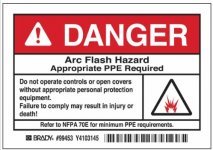Prototype1
Member
- Location
- Kansas City
- Occupation
- Noob EE
I want to get better understanding of Arc flash labels.
I visited five different buildings to inspect electrical panels and determine if they have arc flash labels. Most of the panels lack labels on their doors, though some interior panels bear warnings such as 'Danger: Hazard of electrical shock, explosion, or arc flash.' Among the panels with labels, the attached photo depicts a general warning label indicating 'Danger Arc Flash Hazard.'
However, I am confused as these labels lack additional information, such as 'Arc Flash boundary, Incident energy, Shock hazard, Arc rating, and PPE Category.'
According to the 2023 NEC, the service equipment label now applies to all feeder-supplied equipment rated 1,000A or greater. However, the required information for the label has been removed, with the specification that it should adhere to applicable industry practices and include the date of application.
Referencing NFPA 70e table 130.7(c)15(a), it stipulates specific parameters for panels, such as a maximum of 25KA available fault current, maximum fault clearing time of 0.03 seconds, and a minimum working distance of 455 mm (18 inches), assigning Arc flash PPE category one.
My question pertains to whether the panel must be rated above 240 V or 480 V to necessitate detailed information on 'Arc Flash boundary, Incident energy, Shock hazard, Arc rating, and PPE Category.'
I would appreciate any assistance regarding Arc flash labels.
I visited five different buildings to inspect electrical panels and determine if they have arc flash labels. Most of the panels lack labels on their doors, though some interior panels bear warnings such as 'Danger: Hazard of electrical shock, explosion, or arc flash.' Among the panels with labels, the attached photo depicts a general warning label indicating 'Danger Arc Flash Hazard.'
However, I am confused as these labels lack additional information, such as 'Arc Flash boundary, Incident energy, Shock hazard, Arc rating, and PPE Category.'
According to the 2023 NEC, the service equipment label now applies to all feeder-supplied equipment rated 1,000A or greater. However, the required information for the label has been removed, with the specification that it should adhere to applicable industry practices and include the date of application.
Referencing NFPA 70e table 130.7(c)15(a), it stipulates specific parameters for panels, such as a maximum of 25KA available fault current, maximum fault clearing time of 0.03 seconds, and a minimum working distance of 455 mm (18 inches), assigning Arc flash PPE category one.
My question pertains to whether the panel must be rated above 240 V or 480 V to necessitate detailed information on 'Arc Flash boundary, Incident energy, Shock hazard, Arc rating, and PPE Category.'
I would appreciate any assistance regarding Arc flash labels.

